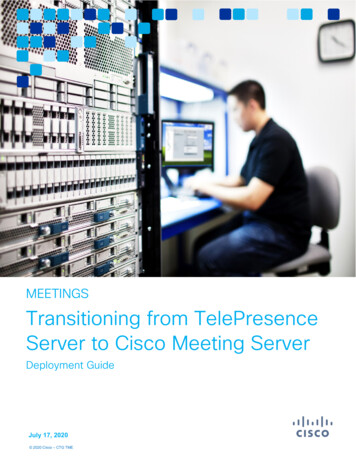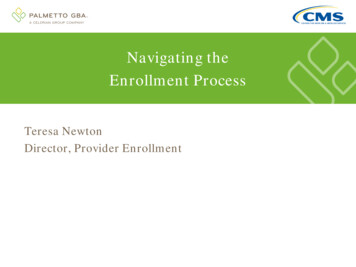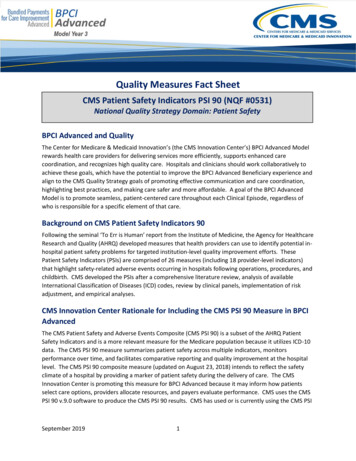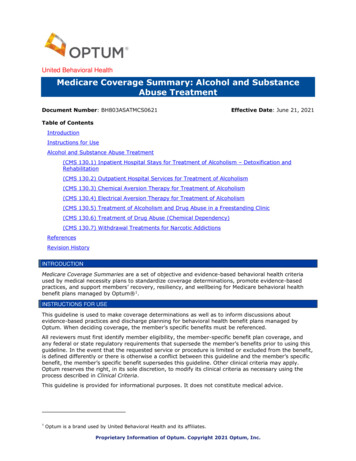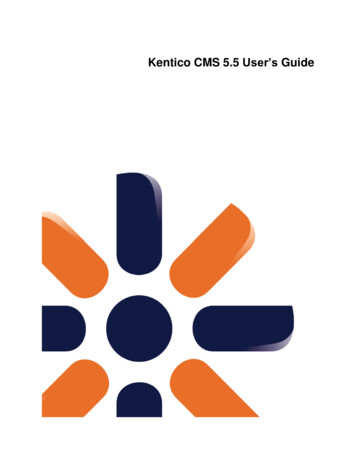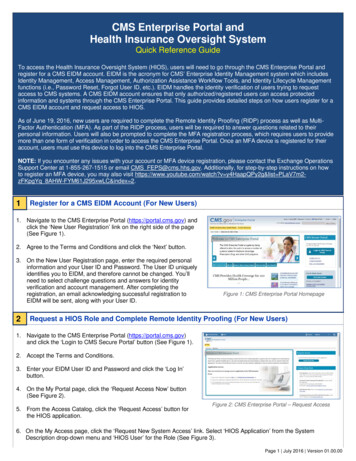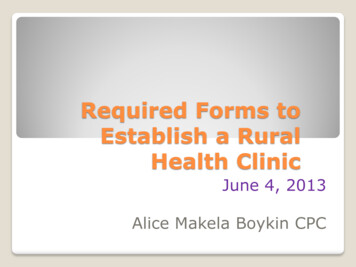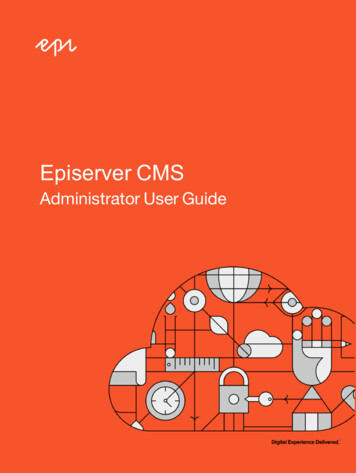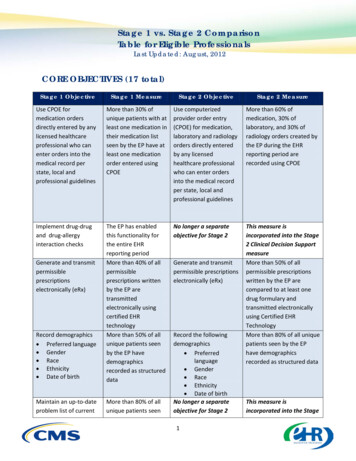
Transcription
Stage 1 vs. Stage 2 ComparisonTable for Eligible ProfessionalsLast Updated: August, 2012CORE OBJECTIVES (17 total)Stage 1 ObjectiveStage 1 MeasureStage 2 ObjectiveStage 2 MeasureUse CPOE formedication ordersdirectly entered by anylicensed healthcareprofessional who canenter orders into themedical record perstate, local andprofessional guidelinesMore than 30% ofunique patients with atleast one medication intheir medication listseen by the EP have atleast one medicationorder entered usingCPOEUse computerizedprovider order entry(CPOE) for medication,laboratory and radiologyorders directly enteredby any licensedhealthcare professionalwho can enter ordersinto the medical recordper state, local andprofessional guidelinesMore than 60% ofmedication, 30% oflaboratory, and 30% ofradiology orders created bythe EP during the EHRreporting period arerecorded using CPOEImplement drug-drugand drug-allergyinteraction checksNo longer a separateobjective for Stage 2Record demographics Preferred language Gender Race Ethnicity Date of birthThe EP has enabledthis functionality forthe entire EHRreporting periodMore than 40% of allpermissibleprescriptions writtenby the EP aretransmittedelectronically usingcertified EHRtechnologyMore than 50% of allunique patients seenby the EP havedemographicsrecorded as structureddataThis measure isincorporated into the Stage2 Clinical Decision SupportmeasureMore than 50% of allpermissible prescriptionswritten by the EP arecompared to at least onedrug formulary andtransmitted electronicallyusing Certified EHRTechnologyMore than 80% of all uniquepatients seen by the EPhave demographicsrecorded as structured dataMaintain an up-to-dateproblem list of currentMore than 80% of allunique patients seenGenerate and transmitpermissibleprescriptionselectronically (eRx)Generate and transmitpermissible prescriptionselectronically (eRx)Record the followingdemographics Preferredlanguage Gender Race Ethnicity Date of birthNo longer a separateobjective for Stage 21This measure isincorporated into the Stage
and active diagnosesMaintain activemedication listMaintain activemedication allergy listRecord and chartchanges in vital signs: Height Weight Blood pressure Calculate anddisplay BMI Plot and displaygrowth charts forchildren 2-20 years,including BMIRecord smoking statusfor patients 13 years oldor olderby the EP have at leastone entry or anindication that noproblems are knownfor the patientrecorded as structureddataMore than 80% of allunique patients seenby the EP have at leastone entry (or anindication that thepatient is not currentlyprescribed anymedication) recordedas structured dataMore than 80% of allunique patients seenby the EP have at leastone entry (or anindication that thepatient has no knownmedication allergies)recorded as structureddataFor more than 50% ofall unique patients age2 and over seen by theEP, blood pressure,height and weight arerecorded as structureddataMore than 50% of allunique patients 13years old or older seenby the EP havesmoking status2 measure of Summary ofCare Document atTransitions of Care andReferralsNo longer a separateobjective for Stage 2This measure isincorporated into the Stage2 measure of Summary ofCare Document atTransitions of Care andReferralsNo longer a separateobjective for Stage 2This measure isincorporated into the Stage2 measure of Summary ofCare Document atTransitions of Care andReferralsRecord and chartchanges in vital signs: Height Weight Blood pressure (age3 and over) Calculate and displayBMI Plot and displaygrowth charts forpatients 0-20 years,including BMIRecord smoking statusfor patients 13 years oldor olderMore than 80% of all uniquepatients seen by the EPhave blood pressure (forpatients age 3 and overonly) and height and weight(for all ages) recorded asstructured data2More than 80% of all uniquepatients 13 years old orolder seen by the EP havesmoking status recorded asstructured data
recorded as structureddataImplement one clinicaldecision support rulerelevant to specialty orhigh clinical priorityalong with the ability totrack compliance thatruleImplement one clinicaldecision support ruleUse clinical decisionsupport to improveperformance on highpriority health conditionsReport clinical qualitymeasures (CQMs) toCMS or the StatesProvide aggregatenumerator,denominator, andexclusions throughattestation or throughthe PQRS ElectronicReporting PilotMore than 50% of allpatients of the EP whorequest an electroniccopy of their healthinformation areprovided it within 3business daysNo longer a separateobjective for Stage 2,but providers must stillsubmit CQMs to CMS orthe States in order toachieve meaningful useProvide patients with anelectronic copy of theirhealth information(including diagnostictest results, problemlist, medication lists,medication allergies),upon requestProvide patients theability to view online,download and transmittheir health informationwithin four business daysof the information beingavailable to the EP31. Implement 5 clinicaldecision supportinterventions related to4 or more clinicalquality measures, ifapplicable, at a relevantpoint in patient care forthe entire EHR reportingperiod.2. The EP, eligible hospital,or CAH has enabled thefunctionality for drugdrug and drug-allergyinteraction checks forthe entire EHR reportingperiodStarting in 2014, all CQMswill be submittedelectronically to CMSi. More than 50% of allunique patients seen bythe EP during the EHRreporting period areprovided timely(available to the patientwithin 4 business daysafter the information isavailable to the EP)online access to theirhealth informationii. More than 5% of allunique patients seen bythe EP during the EHRreporting period (ortheir authorized
Provide clinicalsummaries for patientsfor each office visitCapability to exchangekey clinical information(for example, problemlist, medication list,medication allergies,diagnostic test results),among providers ofcare and patientauthorized entitieselectronicallyProtect electronichealth informationcreated or maintainedby the certified EHRtechnology through theimplementation ofappropriate technicalcapabilitiesImplement drugformulary checksrepresentatives) view,download, or transmitto a third party theirhealth informationClinical summaries providedto patients within onebusiness day for more than50% of office visitsClinical summariesprovided to patientsfor more than 50% ofall office visits within 3business daysPerformed at least onetest of certified EHRtechnology's capacityto electronicallyexchange key clinicalinformationProvide clinicalsummaries for patientsfor each office visitThis objective iseliminated from Stage 1in 2013 and is no longeran objective for Stage 2This measure is eliminatedfrom Stage 1 in 2013 and isno longer a measure forStage 2Conduct or review asecurity risk analysisper 45 CFR 164.308(a)(1) and implementsecurity updates asnecessary and correctidentified securitydeficiencies as part ofits risk managementprocessProtect electronic healthinformation created ormaintained by theCertified EHR Technologythrough theimplementation ofappropriate technicalcapabilities.The EP has enabledthis functionality andhas access to at leastone internal orexternal drugformulary for theentire EHR reportingperiodNo longer a separateobjective for Stage 2Conduct or review asecurity risk analysis inaccordance with therequirements under 45 CFR164.308 (a)(1), includingaddressing theencryption/security of dataat rest and implementsecurity updates asnecessary and correctidentified securitydeficiencies as part of itsrisk management processThis measure isincorporated into the ePrescribing measure forStage 24
Incorporate clinical labtest results into certifiedEHR technology asstructured dataGenerate lists ofpatients by specificconditions to use forquality improvement,reduction of disparities,research or outreachSend reminders topatients per patientpreference forpreventive/ follow upcareProvide patients withtimely electronic accessto their healthinformation (includinglab results, problem list,medication lists,medication allergies)within four businessdays of the informationbeing available to the EPMore than 40% of allclinical lab tests resultsordered by the EPduring the EHRreporting periodwhose results areeither in apositive/negative ornumerical format areincorporated incertified EHRtechnology asstructured dataGenerate at least onereport listing patientsof the EP with aspecific conditionMore than 20% of allunique patients 65years or older or 5years old or youngerwere sent anappropriate reminderduring the EHRreporting periodMore than 10% of allunique patients seenby the EP are providedtimely (available to thepatient within fourbusiness days of beingupdated in thecertified EHRtechnology) electronicaccess to their healthinformation subject tothe EP’s discretion towithhold certaininformationIncorporate clinical labtest results into CertifiedEHR Technology asstructured dataMore than 55% of all clinicallab tests results ordered bythe EP during the EHRreporting period whoseresults are either in apositive/negative ornumerical format areincorporated in CertifiedEHR Technology asstructured dataGenerate lists of patientsby specific conditions touse for qualityimprovement, reductionof disparities, research,or outreachUse clinically relevantinformation to identifypatients who shouldreceive reminders forpreventive/follow-upcareGenerate at least onereport listing patients of theEP with a specific conditionThis objective iseliminated from Stage 1in 2014 and is no longeran objective for Stage 2This measure is eliminatedfrom Stage 1 in 2014 and isno longer a measure forStage 25Use EHR to identify andprovide reminders forpreventive/follow-up carefor more than 10% ofpatients with two or moreoffice visits in the last 2years
Use certified EHRtechnology to identifypatient-specificeducation resources andprovide those resourcesto the patient ifappropriateMore than 10% of allunique patients seenby the EP are providedpatient-specificeducation resourcesUse certified EHRtechnology to identifypatient-specificeducation resources andprovide those resourcesto the patient ifappropriateThe EP who receives apatient from anothersetting of care orprovider of care orbelieves an encounter isrelevant should performmedicationreconciliationThe EP who transitionstheir patient to anothersetting of care orprovider of care orrefers their patient toanother provider of careshould providesummary of care recordfor each transition ofcare or referralThe EP performsmedicationreconciliation for morethan 50% of transitionsof care in which thepatient is transitionedinto the care of the EPThe EP who receives apatient from anothersetting of care orprovider of care orbelieves an encounter isrelevant should performmedication reconciliationThe EP who transitionsor refers their patientto another setting ofcare or provider ofcare provides asummary of carerecord for more than50% of transitions ofcare and referralsThe EP who transitionstheir patient to anothersetting of care orprovider of care or referstheir patient to anotherprovider of care shouldprovide summary of carerecord for eachtransition of care orreferral6Patient-specific educationresources identified byCEHRT are provided topatients for more than 10%of all unique patients withoffice visits seen by the EPduring the EHR reportingperiodThe EP performs medicationreconciliation for more than50% of transitions of care inwhich the patient istransitioned into the care ofthe EP1. The EP who transitionsor refers their patient toanother setting of careor provider of careprovides a summary ofcare record for morethan 50% of transitionsof care and referrals2. The EP who transitionsor refers their patient toanother setting of careor provider of careprovides a summary ofcare record either a)electronicallytransmitted to arecipient using CEHRTor b) where therecipient receives thesummary of care recordvia exchange facilitatedby an organization thatis a NwHIN Exchangeparticipant or isvalidated through an
Capability to submitelectronic data toimmunization registriesor ImmunizationInformation Systemsand actual submissionexcept whereprohibited and inaccordance withapplicable law andpracticeNEWPerformed at least onetest of certified EHRtechnology's capacityto submit electronicdata to immunizationregistries and followup submission if thetest is successful(unless none of theimmunizationregistries to which theEP submits suchinformation have thecapacity to receive theinformationelectronically)NEWCapability to submitelectronic data toimmunization registriesor ImmunizationInformation Systems andactual submission exceptwhere prohibited and inaccordance withapplicable law andpracticeUse secure electronicmessaging to7ONC‑establishedgovernance mechanismto facilitate exchangefor 10% of transitionsand referrals3. The EP who transitionsor refers their patient toanother setting of careor provider of care musteither a) conduct one ormore successfulelectronic exchanges ofa summary of carerecord with a recipientusing technology thatwas designed by adifferent EHR developerthan the sender's, or b)conduct one or moresuccessful tests with theCMS-designated testEHR during the EHRreporting periodSuccessful ongoingsubmission of electronicimmunization data fromCertified EHR Technology toan immunization registry orimmunization informationsystem for the entire EHRreporting periodA secure message was sentusing the electronic
communicate withpatients on relevanthealth information8messaging function ofCertified EHR Technology bymore than 5% of uniquepatients seen during theEHR reporting period
MENU OBJECTIVES (EPs must select 3 of 6 menu objectives)Stage 1 ObjectiveStage 1 MeasureStage 2 ObjectiveStage 2 MeasureCapability to submitelectronic syndromicsurveillance data topublic health agenciesand actual submissionexcept where prohibitedand in accordance withapplicable law andpracticeCapability to submitelectronic syndromicsurveillance data topublic health agenciesand actual submissionexcept where prohibitedand in accordance withapplicable law andpracticeSuccessful ongoing submissionof electronic syndromicsurveillance data fromCertified EHR Technology to apublic health agency for theentire EHR reporting periodNEWPerformed at leastone test of certifiedEHR technology'scapacity to provideelectronic syndromicsurveillance data topublic health agenciesand follow-upsubmission if the testis successful (unlessnone of the publichealth agencies towhich an EP, eligiblehospital or CAHsubmits suchinformation have thecapacity to receive theinformationelectronically)NEWRecord electronic notesin patient recordsNEWNEWEnter at least one electronicprogress note created, editedand signed by an EP for morethan 30% of unique patientsMore than 10% of all scans andtests whose result is an imageordered by the EP for patientsseen during the EHR reportingperiod are incorporated into oraccessible through CertifiedEHR TechnologyNEWNEWImaging resultsconsisting of the imageitself and anyexplanation or otheraccompanyinginformation areaccessible throughCEHRTRecord patient familyhealth history asstructured data9More than 20% of all uniquepatients seen by the EP duringthe EHR reporting period havea structured data entry for oneor more first-degree relativesor an indication that familyhealth history has been
reviewedNEWNEWNEWNEWCapability to identify andreport cancer cases to aState cancer registry,except where prohibited,and in accordance withapplicable law andpracticeCapability to identify andreport specific cases to aspecialized registry(other than a cancerregistry), except whereprohibited, and inaccordance withapplicable law andpractice10Successful ongoing submissionof cancer case informationfrom Certified EHR Technologyto a cancer registry for theentire EHR reporting periodSuccessful ongoing submissionof specific case informationfrom Certified EHR Technologyto a specialized registry for theentire EHR reporting period
Stage 1 vs. Stage 2 Comparison Table for Eligible Professionals Last Updated: August, 2012 . CORE OBJECTIVES (17 total) Stage 1 Objective . Stage 1 Measure ; Stage 2 Objective . . the EP during the EHR reporting period are recorded using CPOE . Implement drug-drug and drug-allergy interaction checks ; The EP has enabled this functionality for
